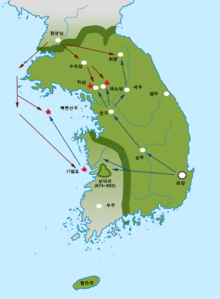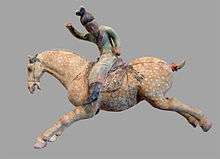Silla–Tang War
| Silla–Tang War | |||||||||
|---|---|---|---|---|---|---|---|---|---|
 Map of the Silla-Tang War (in Korean), with final northern border of Silla marked in dark green line. Red arrows indicate Tang attack routes; blue arrows indicate Silla attack routes; explosion marks indicate battles. | |||||||||
| |||||||||
| Belligerents | |||||||||
|
Silla Goguryeo (vassal of Silla) Baekje (vassal of Silla) | Tang China | ||||||||
| Commanders and leaders | |||||||||
|
King Munmu Kim Yushin Geom Mojam Kim Wonsul Go Yeonmu |
Xue Rengui Gao Kan Buyeo Yung Li Jinxing | ||||||||
The Silla–Tang War (670–676) occurred between the Korean Silla kingdom with the remnant forces from Goguryeo and Baekje (commonly referred to as Unified Silla), and the Chinese Tang dynasty that began in the geopolitical context immediately following the conquest of Goguryeo and Baekje by Silla and Tang China.[3] The conflict ended with a truce between Tang and Silla due to the internal political situation in both states,[1] with the dividing territorial line at the Taedong River basin.
Context
The Silla-Tang alliance, which had defeated both the Korean kingdoms of Baekje and Goguryeo, resulted in the occupation of the former territories of both of these kingdoms by coalition (i.e. Silla and Tang) armies. After the fall of Goguryeo in 668 AD, the Tang Emperor created the office of Protectorate General to Pacify the East and attempted to place the entire Korean Peninsula, including its erstwhile independent ally Silla, under its rule. The Silla-Tang alliance subsequently fell apart as the Tang tried to establish dominion over the Korean Peninsula through this new office and its former ally Silla resisted these efforts.
King Munmu of Silla assembled the Silla army with the armies of the defeated kingdoms Goguryeo and Baekje in a coalition against the Tang army.[4] He had the unenviable challenge of freeing his country and hard-won conquests (particularly the entirety of what was formerly Baekje and some of the southern portions of what was formerly Goguryeo) from Tang domination. To achieve this, Munmu forged alliances with Goguryeo resistance leaders such as Geom Mojam and Anseung, and launched attacks on the Tang forces occupying territories formerly belonging to the conquered kingdoms of Baekje and Goguryeo. Starting almost immediately after the fall of Goguryeo in 668 AD and the establishment of the office of Protectorate General to Pacify the East, the struggle between the former allies lasted through much of the 670s AD.
Notable events
By 674, Tang and Silla were in frequent battle, as King Munmu had taken over much of the former territories of Baekje and Goguryeo from the Tang forces that had occupied these lands following the Goguryeo-Tang War and Baekje–Tang War, and fostered native resistance against the Tang in those territories of the other Korean kingdoms still occupied by the Tang. In this year, Emperor Gaozong, in anger, arbitrarily declared King Munmu's brother Kim Inmun (김인문, 金仁問) to be the king of Silla and commissioned Liu Rengui with an army to attack Silla. However, before any major battles could be fought, King Munmu, for unknown reasons (perhaps unwilling to deal with the potential divisions that could be caused by having a royal pretender loose in his kingdom and unprepared to fight the Tang), formally apologized and offered tribute; this satisfied Emperor Gaozong (he and King Munmu's father, King Muyeol, were actually friends before Gaozong became emperor, and it has been suggested that this relationship not only enabled Gaozong to help King Muyeol start the wars of Korean unification in 660 AD in spite of having active enemies elsewhere, but also caused Gaozong to view Silla in a non-antagonistic manner), and, not wanting to prolong the campaign, he ordered a withdrawal and recalled Kim Inmun.
In 675, Li Jinxing (李謹行) reached Sillan territory via land, using Mohe forces in Manchuria that had submitted to Tang, with the intent of occupying territory in Silla. However, the Tang forces were defeated by a Sillan army at the Maeso fortress, in or near present-day Yeoncheon.
In 676, Xue Rengui crossed the Yellow Sea to fight against Silla.[5] However, a Sillan fleet expelled Tang forces off the coast of western Silla.
Aftermath
Afterwards in 676, the Tang government moved the Protectorate General to Pacify the East to Liaodong.[6] Although the Tang forces lost the conquered territories south of Taedong River, Silla could not regain the former Goguryeo territories to the north of Taedong River, which had fallen into Tang dominion.[2] The Tang empire had taken control of Liaodong Peninsula, while Silla controlled the Korean Peninsula.[4] However, in 698, Dae Jo-yeong, a former Goguryeo general, led a rebellion consisting of Goguryeo-Mohe forces, defeating the Tang dynasty at the Battle of Tianmenling, and established Balhae as a successor to Goguryeo. Balhae would retake most of the former Goguryeo territory, and expand its empire into the northeast. Relations between Tang and Silla ceased until the early 8th century,[4][7] when King Seongdeok of Silla (702–737) and Emperor Xuanzong of Tang (712–755) reestablished diplomatic ties and initiated a reconciliation between the states.[7] Following a revolt of the Eastern Turks in 679 AD, Emperor Gaozong abandoned his plans to invade the Korean Peninsula.
Despite having been enemies of the Tang, a number of officials and commanders of Goguryeo were admitted into the administration and military of the Tang (such as the brothers Yeon Namsaeng and Yeon Namsan, the sons of the late Yeon Gaesomun). Such leaders and officials, as well as their descendants (one notable example of whom was Go Seonji), were assigned to Tang officialdom and provided the dynasty with some capable generals and administrators.
After this conflict, subsequent Korean states (including the administration of Unified Silla) would choose a path of cooperation with the Chinese in order to guarantee their independence and avoid invasions of conquest from China. This strategy proved successful in avoiding assimilation by Chinese powers.
References
- 1 2 Shin, Hyong Sik (2006). A Brief History of Korea (Translated ed.). Seoul: Ewha Womans University Press. p. 51. ISBN 9788973006199.
[...] Silla engaged in an all-out war against Tang at one point. But, a truce was declared due to the political situation in both countries at that time.
- 1 2 Fuqua 2007, 40.
- ↑ Shin, Hyong Sik (2006). A Brief History of Korea (Translated ed.). Seoul: Ewha Womans University Press. p. 51. ISBN 9788973006199.
Tang's territorial ambitions led Silla to wage a war against the Chinese dynasty from 668 to 676. Eventually, Silla joined with remnant forces of Baekje and Goguryeo to drive Tang out of the Korean Peninsula and unified the Three Kingdoms.
- 1 2 3 Ebrey, Walthall & Palais 2006, 107.
- ↑ Boudewijn Walraven, Remco E. Breuker (2007). Remco E. Breuker, ed. Korea in the middle: Korean studies and area studies : essays in honour of Boudewijn Walraven. Volume 153 of CNWS publications (illustrated ed.). CNWS Publications. p. 341. ISBN 9057891530. Retrieved 2012-03-10.
- ↑ Kim 2005, 41.
- 1 2 Shin, Hyong Sik (2006). A Brief History of Korea (Translated ed.). Seoul: Ewha Womans University Press. p. 51. ISBN 9788973006199.
As a consequence, Silla and Tang severed ties and interchanges all but ceased. However, Silla's King Seongdeok(702~737) and Tang's Hsuan Tsung(712~755) saw the need for reestablishing diplomatic ties and initiated a reconciliation.
Bibliography
- Ebrey, Patricia Buckley; Walthall, Anne; Palais, James B. (2006). East Asia: A cultural, social, and political history. Boston: Houghton Mifflin. ISBN 9780618133840.
- Fuqua, Jacques L. (2007). Nuclear endgame: The need for engagement with North Korea. Westport: Praeger Security International. ISBN 9780275990749.
- Kim, Djun Kil (2005). The history of Korea (1st ed.). Westport: Greenwood Press. ISBN 9780313038532.
